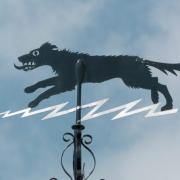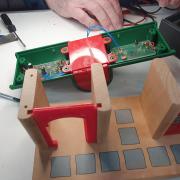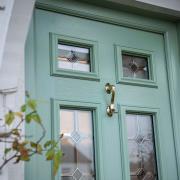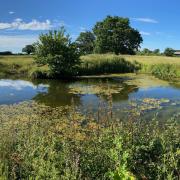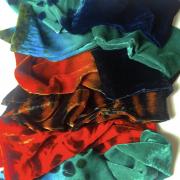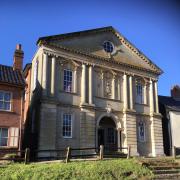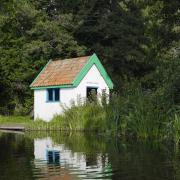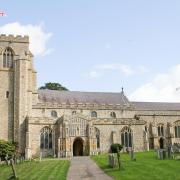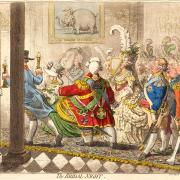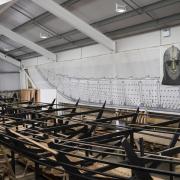I’m in awe of this man Simon Knott who has visited over 3,000 churches across East Anglia and beyond. In Suffolk alone, he’s visited all 500 medieval churches at least three times, often more.
That’s not unusual, he will say modestly, but he stands out among church crawlers for his hugely popular Last of England website. It’s essentially a travelogue of his encounters in and around churches and what they can tell us about people’s lives and their beliefs down the centuries.
Today I’m meeting him at East Suffolk’s most rural railway station at Brampton in the Blyth Valley, where he’s taking pictures as soon as he disembarks that he’ll shortly to post to more than 13,000 followers on X. Let’s call it Twitter, for old time’s sake.

Simon never learned to drive, sensible man, so train and bicycle is his main mode of transport although he’s always been grateful for lifts from friends and family. Today I’m the chauffeur and we’re just minutes from Westall St Andrew, high on the list of his favourite 60 Suffolk churches.
The ‘wow factor’ that Simon likes to use as a starting point when visiting churches is right here as we draw back the curtain beneath the 13th century west tower. Turning round, we’re faced with an arch so surprising, it takes your breath away. ‘The entrance to a grand post Norman conquest church, probably about 1100,’ as Simon puts it. ‘Clearly not finished,’ he adds, pointing to the surviving faces in the curve of the arch that he likens to Wallace and Grommit.
How on earth did he know what happened almost 1,000 years ago? Well he’s seen other arches of the period where 'the faces go all the way round'. That’s the thing about Simon Knott. He’s not only been there and done that, he’s also delved into respected academic research to back up his own discoveries.

Our great 15th century churches were designed to support the Catholic faith and not intended for today’s forms of worship, Simon reminds me, as we study Westall’s famous seven-sacrament font. But such survivals from the past provide a wealth of stories about turbulent times.
‘In the early 16th century in East Anglia it was mad,’ says Simon, as we gaze at all the saints on the medieval chancel screen. ‘There were always new devotions arising.’ One of those was for St Anthony of Egypt painted here with a little pig next to him.
‘St Anthony seems to be a popular saint in Suffolk. In East Anglia, the smallest pig of the litter was the Tantony pig, which was St Anthony’s pig with the bell round his neck.’ I’m wondering about the scratched out faces and quite taken aback when Simon says the damage was almost certainly done by the parishioners themselves around 1530-40. What brought that on? I ask him.

‘Why do you think so many people voted for Brexit?’ Simon replies. ‘It’s a way of kicking back at the establishment. I think a lot of iconoclasm was just that. Your life is being ruled by the church and there’s new ideas coming along but the church doesn’t like it.’ That Suffolk was a strongly protestant area with enthusiastic local reformers in the early years of Henry VIII’s break with with Rome isn’t surprising, but Simon is wary of too-simple narratives. Just like today, not all churches obeyed edicts from above.
Simon tends to do his research after his first visit so ‘the visit you will read about is pretty much the one you would have made yourself’. But clearly the more he re-visits, the more he discovers. I wonder how much social media has impacted his work.
‘Pretty much entirely. You’re constantly alert as to how you can get things across to people and, for me, Twitter is a great way of sending people to our website.’ That website now includes what he modestly describes as an ‘occasional saunter’ round London City churches and a delightful diversion into his family history called Life Goes On. What you will not find on the site are the many churches he has visited beyond East Anglia, in Northern Ireland, Dublin, and the whole of Rutland in 2017-18.

‘Then over the past year, I’ve been to Aberdeen. Leeds, Brighton and Liverpool,’ he laughs. Photos of them are among the 88,500 Simon has stored on Flikr and have prompted comments such as ‘I just fell into Simon’s world’ or ‘This work is monumental’.
As we head towards his number one Suffolk church, another Blyth Valley beauty, I want to know what started all this. It turns out it was a six-year stint as a choir boy in the 1970s at Andrew’s, Chesterton, a suburb of his home town of Cambridge.
‘I’d say it was formative as our choirmaster, Barry Eaden, was one of the most important people in my life, growing up. He galvanised us council estate boys and turned us into this brilliant choir which sang at Ely Cathedral and King’s College Chapel. He had more influence than any of my school teachers.’

It was ‘at the whim of a teacher’s pen’ that he was directed to science subjects rather than art or history at his Cambridge grammar school. He went on to study psychology and linguistics at Sheffield, followed by a post graduate teaching course at the University of Sussex. But he never lost that feeling of being 'at home' in the surroundings of a medieval church.
Not surprisingly he has dedicated his website to ‘my long-suffering and saintly wife, Jacqueline’. The couple moved to Ipswich in 1985 when Simon got a teaching post and Jacqueline as a nurse manager in the NHS. Simon retired in September 2020, while Jacqueline now works for The Reader. Their son, James, is project manager for an advocacy charity in Leeds, while daughter Martha works on the sustainability team at the University of Sussex.
It’s not long before we’re standing under the breath-taking angel roof in 15th century Blythburgh Holy Trinity. ‘But you don’t just come here to see the roof, you come to see the whole church,’ says Simon. That said, we start with the floor – a great expanse of mellow bricks, uneven and broken in places, at the west end where horses might well have been stabled.

That enthralling snapshot might have been lost had it not been for William Morris and the Society for the Protection of Ancient Buildings coming down hard on how the locals wanted to to modernise the church in the 1890s, says Simon. It was a bitter dispute that lasted quarter of a century, but Holy Trinity today is Simon’s ‘wide, white, open space’ bathed in that spiritual quality that is so important to him.
Wandering up the vast nave, Simon points out some of Suffolk’s finest medieval images in the series of bench ends – too many to mention – along with the remarkable carvings on the chancel choir stalls. Simon points out the holes for inkwells, evidence they were not, in fact, choir stalls but the desks of 17th century village schoolchildren which remained in the north aisle chapel until the 19th century. So not all is as it seems.

The easily told story of puritan ‘Basher’ Dowsing of Laxfield wreaking damage and destruction 100 years after the Reformation is a popular one in Suffolk but there’s a bit more to it. ‘The thing about Dowsing is that he kept a record of what he did, but if you read his journal he is giving advice,’ says Simon. ‘He was often welcomed with open arms in Suffolk and Cambridge. They just wanted to know what they had to do to fit in with the law. What they wanted to avoid was the 40shillings fine for not having done anything.’
When did you first come in here? I ask Simon before we leave. ‘Probably about 30 years ago or more. Thrilling isn’t it?’ We’ve been to two churches today, but on his bike, in summer, Simon might visit a dozen or so. Churches are mostly open, he says, but these days he knows how to go back for the key if it’s locked. I remind him of the rather fierce write-ups he used to do when finding a church closed.

‘Well I’m not fierce now but I think you’re missing a trick if people can’t get in. This is what you’re here for.’ He praises churches that defiantly stayed open during the pandemic when they were most needed, like Great Bricett and Nettlestead.
High on his list of favourites is Thornham Parva St Mary, not just because of the famous retable – the largest surviving altarpiece from the English Middle Ages – but also the setting and character of this neat little Norman church under a thatched roof. It’s not only Suffolk’s grand churches he rates highly but those that reflect the people who built it and used it down the generations from the Middle Ages onwards.
St Mary’s Badley, in its remote rural setting, gets his vote for its 'untouched 18th century interior, with barely a sign of Victorian enthusiasm'. He appreciates it was the Victorians who rescued so many Suffolk churches in the 19th century, but Simon feels much of their glass was aimed at 'making the church look medieval again' and can therefore 'tell a lie about the building'. So heavy-handed Victorian glass is not for him.

Simon was received into the Catholic church at the age of 34 and attends mass at St Mary’s in Ipswich, a town he loves. 'It keeps me grounded.’ He loves Norfolk and its churches but thinks a comparison is unfair.
‘Norwich has a much larger hinterland. Ipswich has got Bury and Colchester close by and it’s poorer. Norwich is white and middle class and Ipswich isn’t.’ And the future for church buildings?
‘I do think that it’s heading downhill at fast pace and there doesn’t seem to be a will to stop it. The point is, if we want to keep this inheritance, how do we pay for that? It can’t be a religious decision so you can’t expect the Church of England to implement it. It has to come from the nation because, as John Betjeman says, East Anglia has the largest group of medieval churches in the whole of northern Europe – and if you lose one of them, it’s like losing a pearl from a necklace.’
suffolkchurches.co.uk




